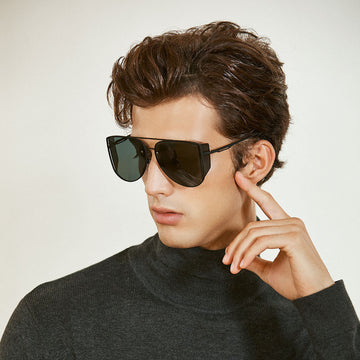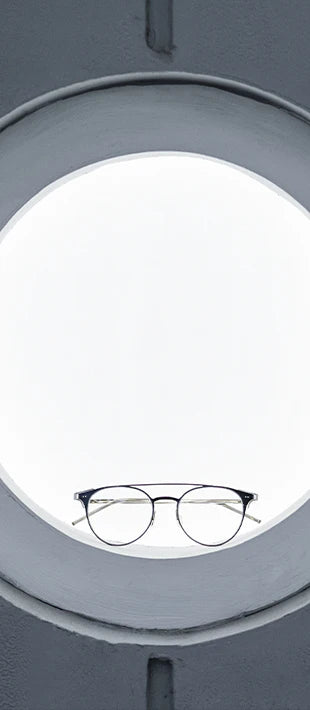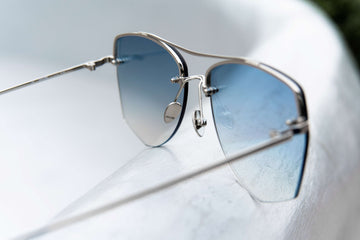Are you struggling to choose gradient lens sunglasses or polarized sunglasses? What is the difference between polarized vs gradient sunglasses? Today, we will compare these two sunglasses in detail to help you select your go-to sunglasses.
Key Takeaways
- Ensure your sunglasses offer 100% UV protection in both lenses.
- Polarized lenses excel in strong reflective environments and are ideal for driving but not suitable for long-term use of electronic screens
- Ombre sunglasses are good for daily activities but underperform in intense sunlight and high-glare places.
- Generally, polarized lenses are more expensive than gradient lenses.
What does gradient mean in sunglasses?
Gradient lens sunglasses are typically designed to gradually darken from the top to the bottom of the lens. The upper part is darker, effectively blocking intense sunlight, while the lower part is lighter, allowing more light to enter and ensuring a clear view in low-light conditions.
What Is Gradient Sunglasses
DEMETER C5 Gradient sunglasses have an adjustable nose pad, which makes them best for high nose bridge or big nose men or women. Also, the blue gradient tint sunglasses elevate your look with the sleek, thin frames. DEMETER is crafted with excellence for a try.
Shop Blue Gradient Sunglasses - DEMETER C5
There are two main types of gradient tint sunglasses available: single gradient lenses and double gradient lenses. Single gradient tint lenses have a darker shade on the top and a lighter shade on the bottom, while double gradient lenses are tinted from both the top down and the bottom up, leaving the midsection the lightest.
Double gradient sunglasses are not the common style. A bit niche, but incredibly unique to evaluate your style and stand out from the copycats.
LUCID Blue Pink Gradient Sunglasses also have an adjustable nose pad, which makes them best-fitting for high nose bridge/big nose or low nose bridge women, such as Asian people. Shop designer gradient sunglasses by MythGreece.
Shop LUCID - Blue Pink Gradient Geometric Sunglasses
Pros:
1. Versatile for multiple scenarios: The gradient lens design provides excellent shielding in strong sunlight, especially blocking more glare from overhead. In a normal environment, things are brighter above (sky & sun) than below, where you’re seeing sidewalks, car dashes, phone screens, etc. Additionally, polarized lenses may be too dark in some settings
2. Fashion design: Gradient tint lenses usually give an elegant and refined impression, especially appealing to travelers who pursue fashion and desire their sunglasses to match their outfits harmoniously. Gradient lenses are also a hit in the 70s sunglasses trend, always being Elton John's favorites.
3. Less expensive: Gradient tint lenses cost less compared to high-quality polarized sunglasses.
Cons:
Limited use in sports or outdoors.
Unsuitable for intense sunlight.
Reduced protection on the lower half of the lens.
Gradient Men's Sunglasses
Shop Aviator Gradient Tint Sunglasses - 2077
Shop Gradient Aviator Sunglasses - ESCHER

Women's Gradient Sunglasses
Shop women's cat-eye gradient sunglasses - LESVOS
Shop Gold Gradient Sunglasses - EPIPHRON cat-eye
Shop Blue Pink Gradient Round Sunglasses- EPOCH
Shop Parallels - Blue Pink Gradient Square Sunglasses

What are polarized sunglasses?
Polarized sunglasses block horizontally polarized light waves using a special filter that aligns light waves to a single vertical plane, reducing glare from surfaces like water, pavement, or snow. High-quality polarized sunglasses use an embedded filter—it works like a built-in Venetian blind—to block horizontal rays, thereby subduing the piercing glare of sunlight reflecting off water or ice.
Many wearers make this mistake: the darker the sunglasses, the better the protection—right? The fact is that darker lenses don't always mean better protection. The most important feature in sunglasses is a polarized UV protection filter, which effectively blocks harmful UV rays. Super dark lenses, such as Category 4 sunglasses, are designed for intense light conditions like skiing, deep-sea fishing, or high-altitude environments—they're not suitable for everyday use. For regular activities like city sightseeing or beach holidays, Category 3 sunglasses, which block 82–92% of visible light, are ideal. That’s why polarized sunglasses offer the most comprehensive and professional eye protection.
Pros:
1. Reduce glare: reduce the reflected light from light-reflective surfaces, greatly reducing eye fatigue, especially suitable for outdoor activities and water sports.
High-glare environments: beaches and ski resorts.
Intense sunlight countries: Greece, Spain, Australia, Mexico, the Middle East, and Africa.
2. Improve visual clarity: As the polarized sunglasses can effectively filter the interfering light, they provide a clearer visual effect than the ordinary lens, especially in the strong light or multi-reflection environment, and the field of view will be sharper.
3. Reduce eye fatigue: Wearing green polarized sunglasses can effectively reduce eye fatigue caused by strong reflection; long-term wear will not cause discomfort, making them suitable for long-time outdoor activities. Polarized sunglasses could perform the best to protect eyes for health concerns.
4. Ideal for driving: Polarized sunglasses are particularly suitable for long drives. They effectively block the reflection of the front car and provide a clear view of the road.
Shop Retro Polarized Sunglasses- EPOCH C2
Cons:
Difficulty in reading LCD screens
Polarized sunglasses block horizontally polarized light to reduce glare, but LCD screens also emit polarized light. When the polarization of the sunglasses and screen misaligns (often at 90°), the light from the screen is partially or completely blocked, making it hard to see. This effect is common with devices like phones, car dashboards, and ATMs, especially at certain angles.
Higher Cost
High-quality polarized lenses are generally more expensive than gradient tint lenses due to their advanced technology for coating.
Where is your destination, and what is the purpose of sunglasses?
Comment here and click here to buy your sunglasses with gradient.























